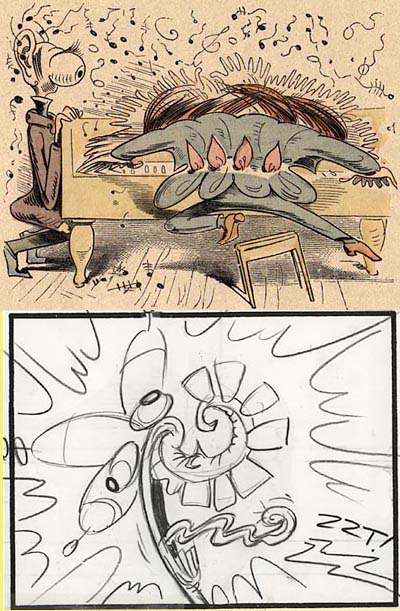
125 Years separate these images.
THE HISTORY OF YOUR MEDIUM IS RELEVANT
TO YOUR WORK AS AN ARTIST!
(Wilhelm Busch 1865 / Bob Camp 1991)
I posted the Ren & Stimpy storyboard the day after I posted the early comic work of Wilhelm Busch in the hopes that someone would notice how much Busch’s pioneering sequential comics look like storyboards. The two Busch stories I posted are perfect examples to study if you are learning to tell stories in pictures.
But no one put two and two together. In fact, because Wilhelm Busch wasn’t a familiar name, most people didn’t even bother to click through to look at it.
The cartoonist who invented sequential comics isn’t a familiar name! What does that say about us as artists working in animation?
I can’t speak for Bob Camp who drew the Ren & Stimpy panel, because I’ve never spoken with him, but here is another Ren & Stimpy storyboard artist speaking at length about Wilhelm Busch…
Uncle Eddie’s Theory Corner: German Cartoonists
I’ve spoken with many successful animators, and their knowledge of the history of cartooning is staggering… Daumier, Nast, Gillray, Cruickshank, Hogarth… They can speak for hours about these artists and have books in their library to refer to for their own work.
What is the difference between you as an animator and Andreas or John K or Ralph Bakshi or Eric Goldberg? It isn’t necessarily talent or skill. A lot of you have talent, and skill just requires concentration and pencil mileage to develop. Every animation studio used to be packed with talented artists like these. I’ll tell you what the difference is. These guys know the history of their medium, and because of that, they push the medium forward instead of just participating in creating the same old same old.
When I post images on Animation Resources, I wonder if anyone bothers to click through the hires links or read the articles. Do you jot down the name in your sketchbook and do further googling? Do you make printouts and try to figure out the techniques for yourself? Or is it just a pretty picture to look at and click like on and never think of again?
These are not just pretty pictures. They aren’t nostalgic memories. They are BUILDING BLOCKS FOR YOUR CREATIVITY.
The material here at Animation Resources comes from the private reference libraries of professional animators. It’s the material they refer to every day in their work… the information that informs their creativity. This isn’t a musueum with specimens pickled in jars of formaldehyde. This is a vital resource for your growth as an artist. If you aren’t bookmarking, studying, filling hard drives with jpegs, learning about the artists from the past and USING THIS STUFF IN YOUR WORK… all the college degrees and knowledge of computer programs in the world won’t make you an animator.
An animator is a CARTOONIST who uses exaggeration and caricature to bring characters to life. If you want to do that for a living, you better know the foundation you are building on or you’ll be operating at a very low level creatively.
I listen in to young animators speaking about animation and I’m shocked at how narrow their experience is. There is more to learn from the history of animation than just Freddie Moore, Milt Kahl and Chuck Jones. If you limit your input to anime, TV animation and 90s Disney, you will never ever go beyond that. You won’t even get that far, because the artists who created those animated films had a MUCH wider frame of reference than you.
Animation is a very competitive business. Being able to build on the foundation of the past will give you an edge, and will allow you to go beyond what everyone else is doing, just like the two artists who drew the sketches at the top of this page. But if you limit yourself and don’t make an effort to assimilate the history of your medium, you will never get anywhere.
.





























